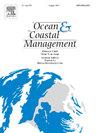Effects of low-frequency climatic-oceanic oscillations on small rivers and their impact on coastal erosion
IF 4.8
2区 环境科学与生态学
Q1 OCEANOGRAPHY
引用次数: 0
Abstract
This study searched to determine whether recent morphological changes at Palomino Beach were attributable to oceanographic variables, or there was a relationship between the discharge of nearby rivers and its morphodynamic response. By analyzing satellite images and changes in the coastline, a notable period of erosion was identified (2012–2022) with rates between −0.20 and −9.39 m year−1, contributing to an area loss of up to 10.20 ha (primarily at the river mouth). Although factors such as current magnitude, wave height, and sea level rise (climate change) influence coastal erosion, the research suggests that they had an insignificant impact on the observed retreat. Otherwise, the characterization of the temporal variability of river discharge showed that the Palomino River went from high streamflows during 2000–2009 to low streamflows during 2010–2021. Therefore, sediment discharge decreased by up to ∼50 %, explaining the consequent erosive process. These changes are not indicative of a long-term trend; instead, they appear to result from the potential combined influence of interannual and interdecadal/low-frequency oscillations (periods between 19 and 23 years) on streamflow variability; in this case, the superposition of oceanographic-atmospheric processes such as the Pacific Decadal Oscillation and the El Niño Southern Oscillation showed high correlations and coherence. The findings underscore the importance of integrating the management of small river watersheds into coastal planning. Additionally, incorporating the hydrological behavior of these rivers (fluvial discharge) will enhance our understanding of morphological changes in the coastal zone.
求助全文
约1分钟内获得全文
求助全文
来源期刊

Ocean & Coastal Management
环境科学-海洋学
CiteScore
8.50
自引率
15.20%
发文量
321
审稿时长
60 days
期刊介绍:
Ocean & Coastal Management is the leading international journal dedicated to the study of all aspects of ocean and coastal management from the global to local levels.
We publish rigorously peer-reviewed manuscripts from all disciplines, and inter-/trans-disciplinary and co-designed research, but all submissions must make clear the relevance to management and/or governance issues relevant to the sustainable development and conservation of oceans and coasts.
Comparative studies (from sub-national to trans-national cases, and other management / policy arenas) are encouraged, as are studies that critically assess current management practices and governance approaches. Submissions involving robust analysis, development of theory, and improvement of management practice are especially welcome.
 求助内容:
求助内容: 应助结果提醒方式:
应助结果提醒方式:


